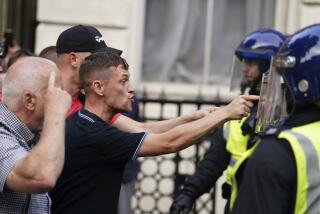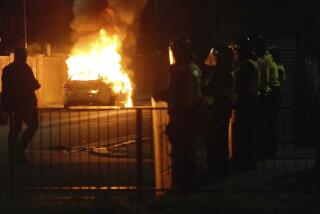Police Get Anti-Riot Arms for First Time in England
- Share via
LONDON — After a dramatic escalation in the level of urban violence, England’s traditionally unarmed police officers are being equipped with anti-riot weaponry for the first time, a senior law officer disclosed Monday.
The development is viewed here as a watershed in the history of England’s police, long regarded as one the most restrained anywhere.
In an eight-hour riot Sunday described as England’s worst ever, one police officer was hacked to death with a machete, seven other people were blasted with a shotgun and 230 police officers and 20 civilians were injured.
Three officers and three news reporters were among those wounded by shotgun pellets. A fourth policeman was hit by a .38-caliber bullet.
As fires smoldered in the north London section of Tottenham, Metropolitan Police Commissioner Kenneth Newman said Monday that guns for firing plastic bullets have been issued to law officers. He said he will “not shrink “ from ordering their use should they be required.
Home Secretary Douglas Hurd supported the controversial decision.
Armed Only With Nightsticks
During the rioting Sunday, the police were armed only with nightsticks. For protection, they also carried plastic shields.
Newman said he had given police unit commanders at the scene permission to use plastic bullets and CS (riot-control) gas in Tottenham, but he added that they had managed to contain the riot without them. The rioting ended just before dawn Monday, when police finally gained control of the housing project.
In the past, English police were issued guns and used them in specific life-threatening encounters with armed criminals. But this is the first time that weaponry is being issued generally, in advance of any specific criminal threat.
Large-diameter plastic bullets have been used for years by police and the British army in Northern Ireland, but never before in England. The bullets are designed to injure rather than kill, but at least 10 people have been fatally wounded by them in Northern Ireland since they were introduced there in the early 1970s.
Newman said police also will be issued CS gas, a temporary disabling agent that has been used only once before in Britain. And he refused to rule out the use of water cannons.
“Yesterday evening (Sunday) marked a tragic turn in the course of public disorder,” Newman said. “You can’t ask men to stand still and just passively receive bricks, bottles, petrol (gasoline) bombs and now bullets. There must be a proper response.”
Move Triggers Debate
His announcement touched off a heated national debate. The National Council for Civil Liberties condemned the decision, which it said will only escalate the level of violence.
Others, however, argued that the rioting was criminally motivated and requires a strong, immediate response to preserve the country’s social fabric.
Senior police officers said the rioters had prepared themselves well in advance. They said that crates of Molotov cocktails had been stockpiled, while bricks and concrete slabs also appeared to have been collected in advance.
Newman maintained that such preparations had begun before Saturday’s police raid on a black family’s home that led to the violence. He called the rioters “murderous young thugs.”
Sunday’s rioting, centered on a small area of a north London public housing project, saw the first recorded death of a British public officer in confronting urban unrest, as well as the first known use of guns by rioters against law enforcement officers.
The officer, Keith Blakelock, a 40-year-old father of three, was attacked by a mob of nearly 100 youths as he tried to protect firemen fighting a supermarket blaze ignited by rioters after they had looted the store. He was stabbed, then hacked to death by a machete.
The area was quiet but tense Monday night, with policemen present in large numbers.
People who witnessed last week’s rioting in the racially mixed south London section of Brixton, as well as similar disturbances in London and other British cities four years ago, described the intensity of the violence in Tottenham as unprecedented.
The unrest began after a 49-year old black woman died, apparently of a heart attack, when the police broke into her family’s home in search of stolen goods.
More to Read
Sign up for Essential California
The most important California stories and recommendations in your inbox every morning.
You may occasionally receive promotional content from the Los Angeles Times.












